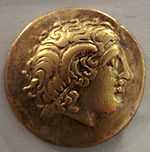List of Celtic tribes
This is a list of Celtic tribes, listed in order of the province or the general area in which they lived.
Central Europe (Vindelicia, Rhaetia, Noricum, Pannonia, Agri Decumates, Bohemia)
Some closely fit the concept of a tribe. Others are confederations or even unions of tribes.
- Boii – areas of modern Germany, Austria, Hungary, Czech Republic, Slovakia[1]
- Cotini – areas of modern Slovakia
- Eravisci – areas of modern Hungary
- Latobrigi – localisation unclear, possibly Southern Germany or Austria near the Upper Rhine
- Lugii – possibly Germanic; areas of modern Poland
- Osi – areas of modern Slovakia[2]
- Scordisci – areas of modern Serbia, Croatia, Austria, Romania
- Tulingi – possibly Germanic; localisation unclear, possibly Southern Germany, Switzerland or Austria
- Varciani – areas of modern Slovenia, Croatia
- Vindelici – areas of modern Germany
- Volcae
Gaul (Gallia)
Cisalpine Gaul (Gallia Cisalpina)

Cisalpine Gaul, meaning literally "Gaul on this side of the Alps", was the Roman name for a region of Italy inhabited by Gauls, roughly corresponding with modern northern Italy. Some closely fit the concept of a tribe. Others are confederations or even unions of tribes.
- Anani – Western Emilia, Po Valley, ( Fidentia, Province of Piacenza )
- Anares – Middle Po Valley, Placentia (Piacenza, Province of Piacenza)
- Boii – Central Emilia-Romagna (Bologna)
- Carni – Northern Friuli
- Cenomani – Eastern Lombardy (Brixia, Cremona)
- Comasci
- Graioceli/Garocelli – Northwestern Piedmont in the Graian Alps
- Insubres – Western Lombardy (Milan)
- Lepontii – Northern Lombardy, North-eastern Piedmont and Switzerland in the Lepontine Alps
- Lingones – North-eastern Emilia-Romagna (Ferrara), Po Valley
- Orobii or Orumbovii – Central Lombardy (Bergamo)
- Salassi – Aosta Valley and Canavese (Northern Piedmont) (Ivrea)
- Segusini (or Cottii) – Western Piedmont on Cottian Alps (Susa)
- Senones – South-eastern Emilia-Romagna (Rimini) and Northern Marche (Senigallia)
- Taurini – Piedmont (Turin)
- Veneti – Veneto
- Vertamocorii – Eastern Piedmont (Novara)
Transalpine Gaul (Gallia Transalpina)
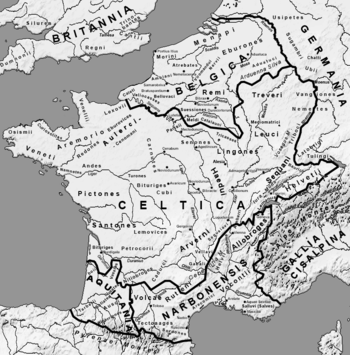
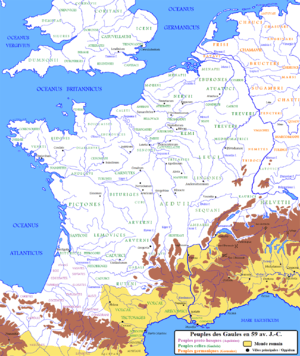
Transalpine Gaul, meaning literally "Gaul on the other side of the Alps" or "Gaul across the Alps", is approximately modern Belgium, France, and Switzerland. At various times it also covered parts of Northern Italy and north-central Spain. The Roman province of Gaul (Gallia) included both Celtic-speaking and non-Celtic-speaking tribes. Some closely fit the concept of a tribe. Others are confederations or even unions of tribes.
List of peoples of Gaul (with their capitals/major settlements):
- Abrincatui
- Adenates – slopes of the Western Alps (Maurienne-Modanne)
- Aedui/Haedui – Bibracte (tribal confederation)
- Aedui proper
- Ambivareti
- Aulerci Brannovices/Brannovii/Blannovii (a southern branch of the Aulerci but within the Aedui tribal confederation)
- Adunicates – Andon area
- Agenisates/Angesinates – Angoumois
- Agnutes – Vendee
- Albici – Middle and Lower Durance river valley (tribal confederation)
- Albienses/Albici Proper
- Vordenses
- Vulgientes
- Allobroges/Allobriges – Vienne
- Ambarri
- Ambibarii/Ambivarii – Armorica
- Ambiliates/Ambilatres – Low Liger (Loire) river
- Anagnutes
- Andecamulenses
- Andecavi/Andes – Angers
- Antobroges
- Armoricani/Aremoricii
- Arverni – Gergovia (tribal confederation)
- Arvii
- Atacini – Aussière
- Atesui
- Aulerci (tribal confederation)
- Avantices
- Avatici – Camargue
- Baiocasses – Bayeux
- Bebryces (Gauls) – in southern Gaul, south of the Volcae Arecomici, close to Narbo (Narbonne) region.
- Belendi/Pelendi – Belinum territory (Belin-Béliet), in the middle Sigmatis river (in today's Leyre river) area, south of the Bituriges Vivisci and the Boii Boiates; they may have been related to the Pellendones (a Celtiberian tribe), not an Aquitanian tribe.
- Belgae[3] (according to classical authors, see Caesar's De Bello Gallico, they were a different people and spoke a different language from the Gauls and Britons; they were clearly an Indo-European people and may have spoken a Celtic language, although there is a remote possibility that their language may have been Pre-Celtic Indo-European; they dwelt in Belgica, parts of Britannia, and may have dwelt in parts of Hibernia and also of Hispania) (large tribal confederation).
- Ambiani – Amiens
- Ambivareti
- Atrebates – Arras
- Bellovaci – Beauvais
- Caleti/Caletes – Harfleur (Caracotinum), later Lillebonne (Juliobona)
- Catuslogi
- Eburones (mixed Belgae and Germani cisrhenani people)
- Leuci – Toul (Tullum Leucorum)
- Mediomatrici – Metz
- Menapii – Cassel
- Morini – Boulogne-sur-Mer
- Nervii – Bavay, (tribal confederation)
- Ceutrones (Belgae)
- Geidumni
- Grudii
- Levaci
- Nervii Proper
- Pleumoxii
- Remi – Reims
- Silvanectii – Senlis
- Suessiones – Soissons (Suessetani may have been related, result of a migration towards south)
- Tencteri – Rhine east bank, may have been a Celtic tribe (and not a Germanic one) or a mixed Belgae and Germani tribe.
- Treveri – Trier
- Usipetes – Rhine east bank, may have been a Celtic tribe (and not a Germanic one) or a mixed Belgae and Germani tribe.
- Veliocasses/Velicasses/Velocasses – Rouen
- Viromandui – Noyon
- Bipedimui/Pimpedunni
- Bituriges Cubi – Bourges
- Bituriges Vivisci – Bordeaux (Burdigala)
- Bodiontici
- Boii – Boui near Entrain[1]
- Boii Boiates/Boviates/Boates – La Tête de Buch, probably around Arcachon Bay and northwest of Landes (departement), may have been a Celtic tribe or a Celtic-Aquitanian tribe.
- Bramovices – Low Tarentaise, Savoy
- Briganii – Briançon, High Durance river valley
- Cadurci – Cahors
- Caeresi
- Cambolectres
- Carnutes – Autricum (Chartres), Cenabum/Genabum (Orleans)
- Catalauni – Châlons-en-Champagne
- Caturiges – Chorges, High Durance river valley
- Cavares/Cavari – North of Low Durance, Arausio (Orange), (tribal confederation)
- Cavares Proper
- Meminii
- Ceutrones/Centrones – Moûtiers
- Chalbici – Chablais
- Coriosolites/Curiosolitae – Corseul
- Corisopiti
- Edenates
- Eleuterii
- Elycoces
- Epomandui
- Esubii/Esuvii/Sesuvii – Ubaye Valley
- Euburiates
- Gaesatae/Gaesati
- Garites – in and around Gariès in the west banks of Garumna river (Garonne), northwest of Tolosa (Toulouse), southwest of Montauban, northwest of the Volcae Tectosages.
- Garumni – along the banks of the high Garumna river (Garonne), southwest of the Volcae Tectosages, and in and around Lugdunum Convenarum, among the Convenae (an Aquitani tribe or group of tribes).
- Geloni
- Graioceli/Garocelli
- Helvetii – La Tène, (tribal confederation).
- Helvii/Elvi
- Iconii – Gap
- Insubres
- Lemovices – Limoges
- Lexovii – Lisieux
- Lingones
- Mandubii – Alesia
- Medulli – Vienne
- Medulli Meduci – Médoc
- Meldi – Marne (Matrona) – Meaux
- Namnetes – Nantes
- Nantuates/Nantuatae
- Nemalones
- Nemeturii – High Var river valley
- Nitiobroges/Nitiobriges
- Osismii
- Parisii – Paris
- Petrocorii – Périgueux
- Pictones/Pictavi – Poitiers
- Quariates
- Raurici/Rauraci – Kaiseraugst (Augusta Raurica)
- Redones – Rennes
- Reieni
- Ruteni – Rodez
- Sagii
- Salyes/Salluvii (may have been a Celtic tribe or a mixed Celtic-Ligurian tribe)
- Santones – Saintes
- Savincates
- Seduni – High Rhône river valley, Sion (Middle Valais, Switzerland)
- Segovellauni
- Segusiavi/Segobriges
- Segusini
- Senates – in Aquitania, south of the Garumna (Garonne) river, but not an Aquitanian tribe
- Senones – Sens
- Sentienes – Senez
- Sequani – Besançon
- Tornates/Turnates
- Tricasses/Tricassini
- Tricorii
- Triviatii
- Trones
- Turones/Turoni – Tours
- Uberi/Viberi – High Rhône river valley, Upper Valais
- Unelli/Venelli – Coutances
- Vadicasses/Vadicassii
- Veamini
- Vediantii
- Vellavi/Velaunii – Ruessium
- Veneti – Vannes
- Veragri
- Vergunni – Vinon-sur-Verdon
- Veroduni
- Vertamocori – Vercors
- Vesubiani – Vésubie
- Viducasses – Vieux
- Vocontii – Vaison-la-Romaine (in modern Provence, on the east bank of the Rhône)
- Volcae Arecomici
- Volcae Tectosages/Tolosates – Toulouse
| |||||||||||||||||||||||||
Great Britain (Britannia)
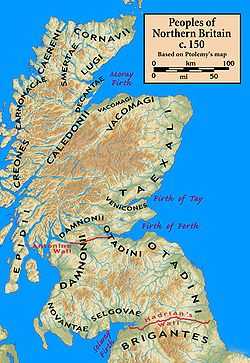

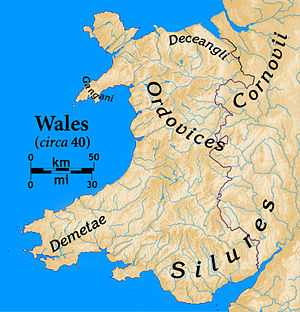
Britannia was the name Romans gave, based on the name of the people: the Britanni. Some closely fit the concept of a tribe. Others are confederations or even unions of tribes.
- Ancalites (uncertain: speculatively Hampshire and Wiltshire)
- Attacotti (origin uncertain)
- Belgae[3] (Wiltshire and Hampshire) (according to classical authors, see Caesar's De Bello Gallico, they were a different people and spoke a different language from the Gauls and Britons; they were clearly an Indo-European people and may have spoken a Celtic language, although there is a remote possibility that their language may have been Pre-Celtic Indo-European; they dwelt in Belgica, parts of Britannia, and may have dwelt in parts of Hibernia and also of Hispania)
- Atrebates – an important Belgic tribe of today's Southern England, in Berkshire
- Belgae (tribe) – Belgic tribe, in today's England's south coast, Isle of Wight, Hampshire, Wiltshire
- Catuvellauni (Hertfordshire) – Belgic tribe, neighbours of the Iceni, they joined in their rebellion
- Regnenses/Regni – Belgic tribe, in today's East Hampshire, Sussex and Surrey
- Bibroci (mentioned by Caesar, location uncertain but possibly Berkshire)
- Boresti (sometimes Horesti) (In or near Fife, Scotland according to Tacitus)
- Brigantes (an important tribe in most of Northern England and in the south-east corner of Ireland)
- Cantiaci (in present-day Kent which preserves the ancient tribal name)
- Carvetii (Cumberland)
- Cassi (mentioned by Caesar, possibly south-east England)
- Cateni (north and west of Sutherland) – they gave the county its Gaelic name Cataibh
- Cenimagni (mentioned by Caesar, perhaps the same as the Iceni)
- Corieltauvi/Coritani (East Midlands including Leicester)
- Corionototae (possibly a tribe) (Northumberland)
- Cornovii (Midlands)
- Damnonii (Southwestern Scotland)
- Deceangli (Flintshire, Wales)
- Demetae (Dyfed, Wales)
- Dobunni (Cotswolds and Severn valley)
- Dumnonii (Devon, Cornwall, Somerset)
- Cornovii (Cornwall) (a sub-tribe, or sept, of the Dumnonii)
- Durotriges (Dorset, south Somerset, south Wiltshire)
- Gabrantovices
- Gangani (Llŷn Peninsula, Wales)
- Iceni (East Anglia) – under Boudica, they rebelled against Roman rule)
- Novantae (Galloway and Carrick)
- Ordovices (Gwynedd, Wales) – they waged guerrilla warfare from the north Wales hills
- Parisii (East Riding of Yorkshire)
- Picts (possibly a different people from the Britons, but were probably also Celtic; tribal confederation)
- Caledones (along the Great Glen)
- Carnonacae (western Highlands)
- Caereni (far western Highlands)
- Cornovii (Caithness)/Cornavii (northernmost known Celtic tribe)
- Creones (Argyll)
- Decantae or Ducantae (eastern Ross and Black Isle)
- Epidii (Kintyre and neighboring islands)
- Lugi (southern Sutherland)
- Smertae (central Sutherland)
- Taexali (Angus and Grampian)
- Vacomagi (in and around the Cairngorms)
- Venicones (Fife and south-west Tayside in Scotland)
- Tribe of unknown name in the Orkney Islands (may have been Picts)
- Tribe of unknown name in the Shetland Islands (may have been Picts)
- Tribe of unknown name in the Faroe Islands (may have been Picts)
- Scotti (western portion of Scotland)
- Segontiaci (probably south-east England)
- Selgovae (Dumfriesshire and the Stewartry of Kirkcudbright)
- Setantii (possibly a tribe) (Lancashire)
- Silures (south Wales) – resisted the Romans in present-day south Wales
- Trinovantes/Trinobantes (Essex) – neighbours of the Iceni, they joined in their rebellion
- Votadini/Otadini (north-east England and south-east Scotland) – they later formed Gododdin
Ireland (Hibernia)

According to Ptolemy's Geography (2nd century AD):
- Autini (or Auteini)
- Brigantes
- Cauci (or Kauki)
- Coriondi (or Koriondi)
- Darini
- Eblani (or Ebdani/Blani)
- Erdini (or Erpeditani)
- Gangani (or Concani)
- Iverni (or Iwerni)
- Manapii
- Nagnatae (or Nagnatai/Magnatae/Magnatai)
- Robogdii (or Redodi)
- Usdiae (or Usdiai/Udiae/Udiai/Vodiae/Wodiai)
- Uterni
- Velabri (or Vellabori/Wellabori)
- Vennicnii (or Wennikni)
- Volunti (or Wolunti) – identifiable with the Ulaidh/Uluti[4]
| ||||||||||||||||||||||
Iberian Peninsula (Hispania)
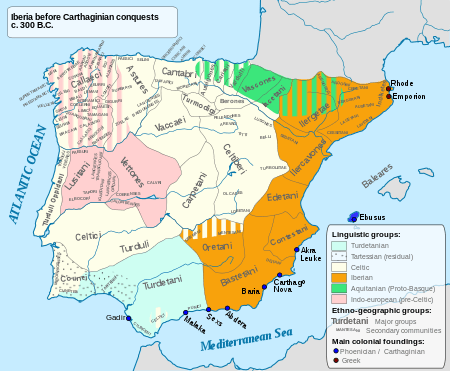
The Celts in the Iberian peninsula were traditionally thought of as living on the edge of the Celtic world of the La Tène culture that defined classical Iron Age Celts. Earlier migrations were Hallstatt in culture and later came La Tène influenced peoples. Celtic or (Indo-European) Pre-Celtic cultures and populations existed in great numbers and Iberia experienced one of the highest levels of Celtic settlement in all of Europe. They dwelt in northern, central and western regions of Iberian Peninsula, but also in several southern regions. The Roman province of Hispania included both Celtic speaking and non-Celtic speaking tribes. Some closely fit the concept of a tribe. Others are confederations or even unions of tribes.
- Allotriges – Northwestern La Rioja (Spain).
- Astures – Asturias and northern León (Spain), and east of Trás os Montes (Portugal), (tribal confederation).
- Cismontani
- Amaci
- Cabruagenigi
- Gigurri
- Lancienses
- Lougei
- Orniaci
- Superatii
- Susarri/Astures Proper
- Tiburi
- Zoelae – Eastern Trás-os-Montes (Portugal), (Miranda do Douro).
- Transmontani
- Baedunienses
- Brigaentini
- Cabarci
- Iburri
- Luggones/Lungones
- Paenii
- Paesici
- Saelini
- Vinciani
- Viromenici
- Cismontani
- Autrigones – east Burgos (Spain).
- Bebryaces/Berybraces – unknown location, may have been related to the Bebryces (gauls) or the Berones, there is also the possibility that it was an old name of the Celtiberians.
- Berones – La Rioja (Spain).
- Bletonesii – Salamanca (Spain).
- Cantabri – Cantabria, part of Asturias and part of Castile-Leon (Spain); some consider them not Celtic, may have been Pre-Celtic Indo-European as could have been the Lusitani and Vettones , (tribal confederation).
- Avarigines
- Blendii/Plentusii/Plentuisii
- Camarici/Tamarici
- Concani
- Coniaci/Conisci
- Moroecani
- Noegi
- Orgenomesci
- Salaeni/Selaeni
- Vadinienses
- Vellici/Velliques
- Caristii/Carietes – today's West Basque Country, they may have been Celtic (see Late Basquisation), they were later assimilated by the Vascones in the 6th and 7th centuries CE; Some consider them not Celtic, may have been a Pre-Celtic Indo-European people as the Lusitani and Vettones could have been. .
- Carpetani – Central Iberian meseta (Spain).
- Celtiberians – Eastern Iberian meseta (Spain), mountains of the headwaters of the rivers Douro, Tagus, Guadiana (Anas), Júcar, Jalón (river), Jiloca (river) and Turia (river), (tribal confederation).
- Arevaci
- Belli
- Cratistii
- Lobetani
- Lusones – Western Zaragoza (province), Eastern Guadalajara (Spain).
- Olcades
- Pellendones/Cerindones, in high Duero river course (Numantia) and neighboring mountains, may also have been related to the Pelendi/Belendi that dwelt in the middle Sigmatis river, today's Leyre (river).
- Titii (Celtiberian)
- Turboletae/Turboleti
- Uraci/Duraci
- Celtici – Portugal south of the Tagus River and north of Guadiana River (Anas), Alentejo and Algarve (Portugal), western Extremadura (Spain), (tribal confederation).
- Cempsi
- Conii – according to some scholars, Conii and Cynetes were two different peoples or tribes and the names were not two different names of the same people or tribe; in this case, the Conii may have dwelt along the northern banks of the middle Anas (Guadiana) river, in today's western Extremadura region of Spain, and were a Celtici tribe wrongly confused with the Cynetes of Cyneticum (Algarve) that dwelt from the west banks of the Low Anas (Guadiana) river further to the south (the celticization of the Cynetes by the Celtici confused the distinction between the two peoples or tribes).[5]
- Mirobrigenses
- Sefes/Saefes
- Celtici of Arunda (Ronda) – southernmost Celtic tribe, in south Turdetania, later Baetica Roman province, (in today's western Málaga Province), Andalucia region.
- Cynetes – Cyneticum (today's Algarve region) and Low Alentejo (Portugal); originally probably Tartessians or similar, later celtized by the Celtici; according to some scholars, Cynetes and Conii were two different peoples or tribes[5] .
- Gallaecians or Callaici – Gallaecia (Spain & Portugal), (tribal confederation).
- Addovi/Iadovi
- Aebocosi
- Albiones/Albioni – western Asturias (Spain).
- Amphiloci
- Aobrigenses
- Arroni/Arrotrebi
- Arrotrebae/Artabri – Northern Galicia (Spain).
- Aunonenses
- Baedi
- Banienses – around Baião Municipality, Eastern Porto District, (Portugal).
- Biballi
- Bracari/Callaeci/Gallaeci Proper – Southeastern Braga District, Braga, Western Porto District, Oporto, (Portugal).
- Brigantes (Callaici tribe) – Northern Bragança District, Bragança, (Portugal).
- Caladuni
- Capori
- Celtici Praestamarici
- Celtici Supertamarici
- Cibarci
- Cileni
- Coelerni/Aquaflavienses – Braga District, Vila Real District (Chaves), (Portugal) and Ourense (Spain).
- Egi
- Egovarri
- Equaesi – Minho and Trás-os-Montes (Portugal).
- Grovii – Minho (Portugal) and Galicia (Spain).
- Iadones
- Interamici/Interamnici – Trás-os-Montes (Portugal).
- Lapatianci
- Lemavi
- Leuni – Minho (Portugal).
- Limici – Lima River banks, Minho (Portugal) and Galicia (Spain).
- Louguei
- Luanqui – Trás-os-Montes (Portugal).
- Naebisoci/Aebisoci
- Namarii
- Namarini
- Narbasi -Minho (Portugal) and Galicia (Spain).
- Nemetati – Minho (Portugal).
- Nerii
- Poemani
- Quaquerni/Querquerni – Minho (Portugal).
- Seurbi – Minho (Portugal).
- Seurri – Sarria Municipality, East Central Galicia (Spain)
- Tamagani – Chaves (Portugal).
- Turodi – Trás-os-Montes (Portugal) and Galicia (Spain).
- Varri
- Gauls (Galli) – Some gaulish tribes may have migrated towards south and crossed the Pyrenees (by the north, the central or the south areas of the mountains) in a second or a third Celtic wave to the Iberian Peninsula. These tribes were different from the Hispano-Celtic/Iberian Celtic tribes.
- Galli (tribe) – along Gallicus (Gállego) river banks, see place names (toponyms) like Forum Gallorum, Gallur, a different tribe from the Suessetani; may have been a tribe related to the Galli (Gauls) and not to the Hispano-Celts/Iberian Celts.
- Volciani – may have been related to the Volcae, located north of the Iberus (Ebro) river but not very precisely; may have been a tribe related to the Galli (Gauls) and not to the Hispano-Celts/Iberian Celts.
- Lusitanians (Lusitani/Bellitani) – Portugal south of the Douro River and north of Tagus River, and northwestern Extremadura (Spain). Currently, the Lusitanians are not considered a Celtic group; their language does not meet the accepted criteria for celticity and the physical evidence supporting a Celtic culture is not clear. Attempts to classify the language have also pointed at an Italic origin.[6] The Lusitanians have also been identified as being a pre-Celtic Indo-European speaking Iberian culture closely related to the neighbouring Vettones tribal confederation.[5] However, under their controversial theory of Celtic originating in Iberia, John T Koch and Barry Cunliffe have proposed a para-Celtic identity for the Lusitanian language and culture.
- Arabrigenses
- Aravi
- Coelarni/Colarni
- Interamnienses
- Lancienses
- Lancienses Oppidani
- Lancienses Transcudani
- Ocelenses Lancienses
- Meidubrigenses
- Paesuri – Douro and Vouga (Portugal).
- Palanti (according to some scholars, these tribes were Lusitanians and not Vettones)[5]
- Calontienses
- Caluri
- Coerenses
- Tangi
- Talures
- Veaminicori
- Mantesani/Mentesani/Mantasani – La Mancha Plateau, Castilla-La Mancha (Spain); were a different people from the Oretani.
- Oretani – northeastern Andalusia, northwest Múrcia and southern fringes of La Mancha, (Spain), mountains of the headwaters of the Guadalquivir (ancient Baetis river); Some consider them not Celtic .
- Plentauri – Northwestern La Rioja (Spain).
- Suessetani - Aragon and Navarra (Spain)
- Turdetani – Today's Western Andalucia (Hispania Baetica), Baetis (Guadalquivir) River valley and basin, Marianus Mons (Sierra Morena), some consider them Celtic.,[7] may have been Pre-Celtic Indo-European people as the Lusitani and Vettones, (also may have been a non-Indo-European people related to the Iberians, but not the same people), (tribal confederation but with a much more centralized power, may have formed an early form of Kingdom or a Proto-civilisation, see Tartessos)
- Cilbiceni – approximately in today's Cádiz Province
- Elbisini/Eloesti/Olbisini – in today's Huelva Province
- Etmanei – in the middle area of Baetis river (Guadalquivir) course and surrounding region, approximately in today's Córdoba Province
- Gletes/Galetes/Ileates – in Marianus Mons (Sierra Morena), approximately in today's northern areas of the provinces of Huelva, Seville and Córdoba
- Turdetani/Tartessii Proper – in the low course of Baetis river (Guadalquivir) and surrounding region, approximately in today's Seville Province
- Turduli – Guadiana valley (Portugal) and Extremadura (Spain); may have been related to Lusitanians, Callaeci or Turdetani.
- Turduli Bardili – Setubal Peninsula (Portugal); may have been related to Lusitanians, Callaeci or Turdetani.
- Turduli Oppidani – Estremadura (Portugal); may have been related to Lusitanians, Callaeci or Turdetani.
- Turduli Veteres – Southern Douro banks, between Douro and Vouga River, Aveiro District, (Portugal); may have been related to Lusitanians, Callaeci or Turdetani.
- Turmodigi or Turmogi- Central Burgos.
- Vaccaei – Central Iberian meseta (Spain).
- Varduli – today's East Basque Country, they may have been Celtic (see Late Basquisation), they were later assimilated by the Vascones in the 6th and 7th centuries CE; Some consider them not Celtic, may have been a Pre-Celtic Indo-European people as the Lusitani and Vettones could have been. .
- Vettones – Ávila and Salamanca (Spain), may have been a Pre-Celtic Indo-European people, closely related to the Lusitani, (tribal confederation).
- Calontienses? (according to some scholars, these tribes were Lusitanians and not Vettones)[5]
- Caluri?
- Coerenses?
Balkans
Dacia and Thrace
Some closely fit the concept of a tribe. Others are confederations or even unions of tribes.
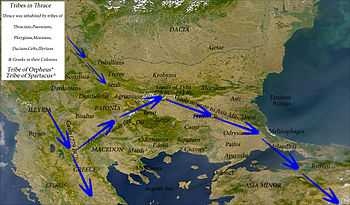
This list includes tribes parts of which migrated to Dacia and Thrace.
- Anartoi, Celts assimilated by Dacians[8]
- Bastarnae,[9][10] Celtic or Germanic, and according to Livy "the bravest nation on earth"
- Boii [11]
- Eravisci [11]
- Gauls of Tylis [12]
- Scordisci [13]
- Serdi [14][15]
- Teuriscii, Celts assimilated by Dacians[8]
Illyria
Some closely fit the concept of a tribe. Others are confederations or even unions of tribes.

This list includes tribes parts of which migrated to Illyria.
- Arabiates [16]
- Belgites [17]
- Boii [18]
- Celegeri [19]
- Celengeri
- Cornacates [20]
- Hercuniates [21]
- Iapodes/Japodes [22][23]
- Latobici,[25]
- Scordisci [26]
- Serrapilli
- Serretes [29]
- Tricornenses [30]
- Varciani [25]
Anatolia
In the 3rd century BC, Gauls immigrated from Thrace into the highlands of central Anatolia (modern Turkey).These people, called Galatians, were eventually Hellenized,[31][32] but retained many of their own traditions. Some closely fit the concept of a tribe. Others are confederations or even unions of tribes.
- Galatians
- Aigosages,[33] between Troy and Cyzicus
- Daguteni,[33] in modern Marmara region around Orhaneli
- Inovanteni,[33] east of the Trocnades
- Okondiani,[33] between Phrygia and Galatia northeast of modern Akşehir Gölü
- Rigosages,[33] unlocated
- Tectosages,[33] in Galatia
- Tolistobogii,[33] in Galatia
- Trocmii,[33] in Galatia (easternmost known Celtic tribe)
- Trocnades,[33] in Phrygia around modern Sivrihisar
- Territory of Gaezatorix,[33] between Bithynia and Galatia at modern Bolu (unknown tribe)
See also
- The summary table on Celtic tribes
- Celticization
- Late Basquisation
- Illyrians
- Thracians
- Britannia
- Caledonia
- Hibernia
- Scotia
- Hispania
- Iberia
Notes
- ↑ 1.0 1.1 Koch, John T. (2006). Celtic culture: a historical encyclopedia (illustrated ed.). Santa Barbara, California: ABC-CLIO. pp. 224–225. ISBN 1-85109-440-7, ISBN 978-1-85109-440-0.
- ↑ The Osi's categorization as Celtic is disputed; see Osi.
- ↑ 3.0 3.1 Koch, John T. (2006). Celtic culture: a historical encyclopedia (illustrated ed.). Santa Barbara, California: ABC-CLIO. pp. 198–200. ISBN 1-85109-440-7, ISBN 978-1-85109-440-0.
- ↑ The Encyclopedia of Ireland, B. Lalor and F. McCourt editors, © 2003 New Haven: Yale University Press, p. 1089 ISBN 0-300-09442-6, noting that Ulaidh was the original tribal designation of the Uluti, who are identifiable as the Voluntii of the Ptolomey map and who occupied, at start, all of the historic province of Ulster.
- ↑ 5.0 5.1 5.2 5.3 5.4 Jorge de Alarcão, “Novas perspectivas sobre os Lusitanos (e outros mundos)”, in Revista portuguesa de Arqueologia, vol. IV, n° 2, 2001, p. 312 e segs.
- ↑ Indoeuropeos y no Indoeuropeos en la Hispania Prerromana, Salamanca: Universidad, 2000
- ↑ Koch, John T. (2006). Celtic culture: a historical encyclopedia (illustrated ed.). Santa Barbara, California: ABC-CLIO. pp. 198–200. ISBN 1-85109-440-7, ISBN 978-1-85109-440-0. ^ Jump up to: a b Koch, John T. (2006). Celtic culture: a historical encyclopedia (illustrated ed.). Santa Barbara, California: ABC-CLIO. pp. 224–225. ISBN 1-85109-440-7, ISBN 978-1-85109-440-0.
- ↑ 8.0 8.1 Ioana A. Oltean, Dacia: Landscape, Colonization and Romanization, ISBN 0-415-41252-8, 2007, p. 47.
- ↑ Adrian Goldsworthy, How Rome Fell: Death of a Superpower, ISBN 0-300-13719-2, 2009, p. 105: "... who had moved to the Hungarian Plain. Another tribe, the Bastarnae, may or may not have been Germanic. ..."
- ↑ Christopher Webber and Angus McBride, The Thracians 700 BC-AD 46 (Men-at-Arms), ISBN 1-84176-329-2, 2001, p. 12: "... never got near the main body of Roman infantry. The Bastarnae (either Celts or Germans, and `the bravest nation on earth' – Livy ..."
- ↑ 11.0 11.1 Ion Grumeza, Dacia: Land of Transylvania, Cornerstone of Ancient Eastern Europe, ISBN 0-7618-4465-1, 2009, p. 51: "In a short time the Dacians imposed their conditions on the Anerati, Boii, Eravisci, Pannoni, Scordisci,"
- ↑ Frank W. Walbank, Polybius, Rome and the Hellenistic World: Essays and Reflections, ISBN 0-521-81208-9, 2002, p. 116: "... in A7P 60 (1939) 452 8, is not Antigonus Doson but barbarians from the mainland (either Thracians or Gauls from Tylis) (cf. Rostovizef and Welles (1940) 207-8, Rostovizef (1941) 111, 1645), nor has that inscription anything to do with the Cavan expedition. On ..."
- ↑ J. J. Wilkes, The Illyrians, 1992, ISBN 0-631-19807-5, p. 140: "... Autariatae at the expense of the Triballi until, as Strabo remarks, they in their turn were overcome by the Celtic Scordisci in the early third century BC ..."
- ↑ John Boardman, I. E. S. Edwards, E. Sollberger, and N. G. L. Hammond, The Cambridge Ancient History, Vol. 3, Part 2: The Assyrian and Babylonian Empires and Other States of the Near East, from the Eighth to the Sixth Centuries BC, ISBN 0-521-22717-8, 1992, p. 600: "In the place of the vanished Treres and Tilataei we find the Serdi for whom there is no evidence before the first century BC. It has for long been supposed on convincing linguistic and archeological grounds that this tribe was of Celtic origin"
- ↑ Dio Cassius, Earnest Cary, and Herbert B. Foster, Dio Cassius: Roman History, Vol. IX, Books 71–80 (Loeb Classical Library, No. 177), 1927, Index: "... 9, 337, 353 Seras, philosopher, condemned to death, 8. 361 Serdi, Thracian tribe defeated by M. Crassus, 6. 73 Seretium,""
- ↑ Andrea Faber, Körpergräber des 1.-3. Jahrhunderts in der römischen Welt: internationales Kolloquium, Frankfurt am Main, 19.-20. November 2004, ISBN 3-88270-501-9, p. 144.
- ↑ Géza Alföldy, Noricum, Tome 3 of History of the Provinces of the Roman Empire, 1974, p. 69.
- ↑ A. Mocsy and S. Frere, Pannonia and Upper Moesia. A History of the Middle Danube Provinces of the Roman Empire. p. 14.
- ↑ J. J. Wilkes, The Illyrians, 1992, ISBN 0-631-19807-5, p. 217.
- ↑ Velika Dautova-Ruševljan and Miroslav Vujović, Rimska vojska u Sremu, 2006, p. 131: "extended as far as Ruma whence continued the territory of another community named after the Celtic tribe of Cornacates"
- ↑ John T. Koch, Celtic culture: a historical encyclopedia, ISBN 1-85109-440-7, 2006, p. 907.
- ↑ Charles Anthon, A Classical Dictionary: Containing The Principal Proper Names Mentioned In Ancient Authors, Part One, 2005, p. 539: "... Tor, " elevated," " a mountain. (Strabo, 293)"; "the Iapodes (Strabo, 313), a Gallo-Illyrian race occupying the valleys of ..."
- ↑ J. J. Wilkes, The Illyrians, 1992, ISBN 0-631-19807-5, p. 79: "along with the evidence of name formulae, a Venetic element among the Japodes. A group of names identified by Alföldy as of Celtic origin: Ammida, Andes, Iaritus, Matera, Maxa,"
- ↑ J. J. Wilkes, Dalmatia, Tome 2 of History of the Provinces of the Roman Empire, 1969, pp. 154 and 482.
- ↑ 25.0 25.1 J. J. Wilkes, The Illyrians, 1992, ISBN 0-631-19807-5, p. 81: "In Roman Pannonia the Latobici and Varciani who dwelt east of the Venetic Catari in the upper Sava valley were Celtic but the Colapiani of ..."
- ↑ J. J. Wilkes, The Illyrians, 1992, ISBN 0-631-19807-5, p. 140: "... Autariatae at the expense of the Triballi until, as Strabo remarks, they in their turn were overcome by the Celtic Scordisci in the early third century"
- ↑ Wilkes, J. J. The Illyrians, 1992,ISBN 0-631-19807-5,page 217,"... with high mountains, Siculotae (24), Glintidiones (44) and Scirtari, who dwelt along the border with Macedonia. In northeast Bosnia the Dindari are located by the record of one of their chiefs (principes) in the Drina valley"
- ↑ Population and economy of the eastern part of the Roman province of Dalmatia, 2002, ISBN 1-84171-440-2, p. 24: "the Dindari were a branch of the Scordisci"
- ↑ Dubravka Balen-Letunič, 40 godina arheoloških istraživanja u sjeverozapadnoj Hrvatskoj, 1986, p. 52: "and the Celtic Serretes"
- ↑ Alan Bowman, Edward Champlin, and Andrew Lintott, The Cambridge Ancient History, Vol. 10: The Augustan Empire, 43 BC-AD 69, 1996, p. 580: "... 580 I3h. DANUBIAN AND BALKAN PROVINCES Tricornenses of Tricornium (Ritopek) replaced the Celegeri, the Picensii of Pincum ..."
- ↑ William M. Ramsay, Historical Commentary on Galatians, 1997, p. 302: "... these adaptable Celts were Hellenized early. The term Gallograecia, compared with Themistius' (p. 360) Γαλατία ..."
- ↑ Roger D. Woodard, The Ancient Languages of Asia Minor, 2008, p. 72: "... The Phrygian elite (like the Galatian) was quickly Hellenized linguistically; the Phrygian tongue was devalued and found refuge only ..."
- ↑ 33.0 33.1 33.2 33.3 33.4 33.5 33.6 33.7 33.8 33.9 Prifysgol Cymru, University of Wales, A Detailed Map of Celtic Settlements in Galatia, Celtic Names and La Tène Material in Anatolia, the Eastern Balkans, and the Pontic Steppes.
References
- Alberro, Manuel and Arnold, Bettina (eds.), e-Keltoi: Journal of Interdisciplinary Celtic Studies, Volume 6: The Celts in the Iberian Peninsula, University of Wisconsin – Milwaukee, Center for Celtic Studies, 2005.
- Haywood, John. (2001). Atlas of the Celtic World. London: Thames & Hudson. ISBN 0500051097 ISBN 978-0500051092
- Kruta, Venceslas. (2000). Les Celtes, Histoire et Dictionnaire. Paris: Éditions Robert Laffont, coll. « Bouquins ». ISBN 2-7028-6261-6.
External links
- http://penelope.uchicago.edu/Thayer/E/Roman/home.html – 51 complete works of authors from Classical Antiquity (Greek and Roman).
- http://penelope.uchicago.edu/Thayer/E/Roman/Texts/Caesar/Gallic_War/home.html – Julius Caesar text of De Bello Gallico (Gallic War).
- http://penelope.uchicago.edu/Thayer/E/Roman/Texts/Caesar/Spanish_War/home.html – Unknown author text (about Julius Caesar in Hispania) of De Bello Hispaniensi (Spanish War).
- http://penelope.uchicago.edu/Thayer/E/Roman/Texts/Pliny_the_Elder/home.html – Pliny the Elder text of Naturalis Historia (Natural History) – books 3–6 (Geography and Ethnography).
- http://penelope.uchicago.edu/Thayer/E/Roman/Texts/Strabo/home.html – Strabo's text of De Geographica (The Geography).
| ||||||||||||||||||||||||||||||||||||||||||||||
